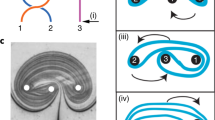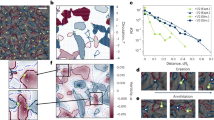Abstract
Active fluids, such as cytoskeletal filaments, bacterial colonies and epithelial cell layers, exhibit distinctive orientational coherence, often characterized by nematic order and its breakdown, defined by the presence of topological defects. In contrast, little is known about positional coherence, that is, whether there is an organization in the underlying fluid motion—despite this being both a prominent and an experimentally accessible feature. Here we characterize the organization of fluid motion in active nematics using the notion of Lagrangian coherent structures by analyzing experimental data of two-dimensional mixtures of microtubules and kinesin, as well as numerical data obtained from the simulation of the active nematodynamic equations. Coherent structures consist of moving attractors and repellers, which orchestrate complex motion. To understand the interaction of positional and orientational coherence, we analyse experiments and simulations and find that +1/2 defects move and deform the attractors, functioning as control centres for collective motion. Additionally, we find that regions around isolated +1/2 defects undergo high bending and low stretching/shearing deformations, consistent with the local stress distribution. The stress is the minimum at the defect, whereas high differential stress along the defect orientation induces folding. Our work offers a new perspective to describe and control self-organization in active fluids, with potential applications to multicellular systems.
This is a preview of subscription content, access via your institution
Access options
Access Nature and 54 other Nature Portfolio journals
Get Nature+, our best-value online-access subscription
$29.99 / 30 days
cancel any time
Subscribe to this journal
Receive 12 print issues and online access
$209.00 per year
only $17.42 per issue
Buy this article
- Purchase on Springer Link
- Instant access to full article PDF
Prices may be subject to local taxes which are calculated during checkout





Similar content being viewed by others
Data availability
The experimental and simulated data that support the findings of this study are available from the corresponding authors upon request.
Code availability
The codes used in this work are available from the corresponding authors upon request.
References
Vicsek, T. & Zafeiris, A. Collective motion. Phys. Rep. 517, 71–140 (2012).
Marchetti, M. C. et al. Hydrodynamics of soft active matter. Rev. Mod. Phys. 85, 1143–1189 (2013).
Kruse, K., Joanny, J., Jülicher, F., Prost, J. & Sekimoto, K. Asters, vortices, and rotating spirals in active gels of polar filaments. Phys. Rev. Lett. 92, 078101 (2004).
Ballerini, M. et al. Interaction ruling animal collective behavior depends on topological rather than metric distance: evidence from a field study. Proc. Natl Acad. Sci. USA 105, 1232–1237 (2008).
Zhang, H., Ber, A., Florin, E. & Swinney, H. Collective motion and density fluctuations in bacterial colonies. Proc. Natl Acad. Sci. USA 107, 13626–13630 (2010).
Bricard, A., Caussin, J., Desreumaux, N., Dauchot, O. & Bartolo, D. Emergence of macroscopic directed motion in populations of motile colloids. Nature 503, 95–98 (2013).
Dombrowski, C., Cisneros, L., Chatkaew, S., Goldstein, R. & Kessler, J. Self-concentration and large-scale coherence in bacterial dynamics. Phys. Rev. Lett. 93, 098103 (2004).
Copenhagen, K., Alert, R., Wingreen, N. S. & Shaevitz, J. W. Topological defects promote layer formation in Myxococcus xanthus colonies. Nat. Phys. 17, 211–215 (2021).
Meacock, O. J., Doostmohammadi, A., Foster, K. R., Yeomans, J. M. & Durham, W. M. Bacteria solve the problem of crowding by moving slowly. Nat. Phys. 17, 205–210 (2021).
Friedl, P. & Gilmour, D. Collective cell migration in morphogenesis, regeneration and cancer. Nat. Rev. Mol. Cell Biol. 10, 445–457 (2009).
Ladoux, B. & Mège, R. Mechanobiology of collective cell behaviours. Nat. Rev. Mol. Cell Biol. 18, 743–757 (2017).
Doostmohammadi, A., Ignés-Mullol, J., Yeomans, J. & Sagués, F. Active nematics. Nat. Commun. 9, 3246 (2018).
Serra, M., Streichan, S., Chuai, M., Weijer, C. J. & Mahadevan, L. Dynamic morphoskeletons in development. Proc. Natl Acad. Sci. USA 117, 11444–11449 (2020).
Wensink, H. et al. Meso-scale turbulence in living fluids. Proc. Natl Acad. Sci. USA 109, 14308–14313 (2012).
Giomi, L. Geometry and topology of turbulence in active nematics. Phys. Rev. X 5, 031003 (2015).
Shankar, S. & Marchetti, M. C. Hydrodynamics of active defects: from order to chaos to defect ordering. Phys. Rev. X 9, 041047 (2019).
Tan, A. J. et al. Topological chaos in active nematics. Nat. Phys. 15, 1033–1039 (2019).
Haller, G. Lagrangian coherent structures. Annu. Rev. Fluid Mech. 47, 137–162 (2015).
Serra, M. & Haller, G. Objective Eulerian coherent structures. Chaos 26, 053110 (2016).
Hadjighasem, A., Farazmand, M., Blazevski, D., Froyland, G. & Haller, G. A critical comparison of Lagrangian methods for coherent structure detection. Chaos 27, 053104 (2017).
Serra, M., Sathe, P., Beron-Vera, F. & Haller, G. Uncovering the edge of the polar vortex. J. Atmos. Sci. 74, 3871–3885 (2017).
Serra, M. et al. Search and rescue at sea aided by hidden flow structures. Nat. Commun. 11, 2525 (2020).
Nolan, P. J., Serra, M. & Ross, S. D. Finite-time Lyapunov exponents in the instantaneous limit and material transport. Nonlinear Dyn. 100, 3825–3852 (2020).
Truesdell, C. & Noll, W. The Non-Linear Field Theories of Mechanics (Springer, 2004).
Giona, M. & Adrover, A. Nonuniform stationary measure of the invariant unstable foliation in Hamiltonian and fluid mixing systems. Phys. Rev. Lett. 81, 3864 (1998).
Serra, M., Vétel, J. & Haller, G. Exact theory of material spike formation in flow separation. J. Fluid Mech. 845, 51–92 (2018).
Sanchez, T., Chen, D., DeCamp, S., Heymann, M. & Dogic, Z. Spontaneous motion in hierarchically assembled active matter. Nature 491, 431–434 (2012).
De Gennes, P. & Prost, J. The Physics of Liquid Crystals 2nd edn (Oxford Univ. Press, 1993).
Shendruk, T. N., Doostmohammadi, A., Thijssen, K. & Yeomans, J. M. Dancing disclinations in confined active nematics. Soft Matter 13, 3853–3862 (2017).
Doering, C. R. & Thiffeault, J.-L. Multiscale mixing efficiencies for steady sources. Phys. Rev. E 74, 025301 (2006).
Saw, T. et al. Topological defects in epithelia govern cell death and extrusion. Nature 544, 212–216 (2017).
Kawaguchi, K., Kageyama, R. & Sano, M. Topological defects control collective dynamics in neural progenitor cell cultures. Nature 545, 327–331 (2017).
Dreher, D., Pasakarnis, L. & Brunner, D. Snapshot: mechanical forces in development II. Cell 165, 1028–1028 (2016).
Aragona, M. et al. A mechanical checkpoint controls multicellular growth through YAP/TAZ regulation by actin-processing factors. Cell 154, 1047–1059 (2013).
Balasubramaniam, L. et al. Investigating the nature of active forces in tissues reveals how contractile cells can form extensile monolayers. Nat. Mater. 20, 1156–1166 (2021).
Maroudas-Sacks, Y. et al. Topological defects in the nematic order of actin fibres as organization centres of hydra morphogenesis. Nat. Phys. 17, 251–259 (2021).
Acknowledgements
We acknowledge T. N. Shendruk, A. Doostmohammadi, K. Thijssen and J. M. Yeomans for providing the dataset29 analysed in Supplementary Fig. 3. We are grateful to S. Shankar and N. Molinari for helpful discussions. This work is partially supported by the Schmidt Science Fellowship and the Postdoc Mobility Fellowship from the Swiss National Foundation (M.S.); the Netherlands Organization for Scientific Research (NWO/OCW) as part of the Frontiers of Nanoscience program and the Vidi scheme (L.G.); the Department of Energy, Office of Basic Energy Sciences, under award no. DESC0019733 (Z.D.); and the NSF Simons Center for Mathematical and Statistical Analysis of Biology via award no. 1764269 (L.M.).
Author information
Authors and Affiliations
Contributions
M.S. and L.M. designed research, M.S. performed the research. M.S., L.L., L.G., Z.D. and L.M. contributed to the new experimental, numerical and analytical tools. M.S., L.L., L.G., Z.D. and L.M. analysed the data, and M.S. and L.M. wrote the manuscript. All authors commented on the manuscript.
Corresponding authors
Ethics declarations
Competing interests
The authors declare no competing interests.
Peer review
Peer review information
Nature Physics thanks the anonymous reviewers for their contribution to the peer review of this work
Additional information
Publisher’s note Springer Nature remains neutral with regard to jurisdictional claims in published maps and institutional affiliations.
Supplementary information
Supplementary Information
Supplementary Sections 1–10 and Figs. 1–10.
Supplementary Video 1
Time evolution video associated with Fig. 2a–c.
Supplementary Video 2
Time evolution video associated with Fig. 2d–f.
Supplementary Video 3
Time evolution video associated with Fig. 3.
Supplementary Video 4
Time evolution video associated with Fig. 4.
Supplementary Video 5
Time evolution of defect velocities and backward FTLE field associated with Fig. 4 for increasing T.
Supplementary Video 6
Time evolution of defect velocities and backward FTLE field associated with Fig. 3 for increasing T.
Supplementary Video 7
Time evolution video associated with Supplementary Fig. 4.
Supplementary Video 8
Time evolution video associated with Supplementary Fig. 2.
Supplementary Video 9
Time evolution of defect velocities and backward FTLE field associated with Supplementary Fig. 4 for increasing T.
Supplementary Video 10
Eulerian and Lagrangian analyses of the dancing disclinations flow in confined active nematics (Supplementary Section 6).
Supplementary Video 11
Time evolution video associated with Supplementary Fig. 6.
Supplementary Video 12
Time evolution video associated with Supplementary Fig. 7a.
Supplementary Video 13
Time evolution video associated with Supplementary Fig. 8a,b.
Supplementary Video 14
Time evolution video associated with Supplementary Fig. 8d–i.
Supplementary Video 15
Time evolution video associated with Supplementary Fig. 9a–i.
Supplementary Video 16
Time evolution video associated with Supplementary Fig. 10a–i.
Rights and permissions
Springer Nature or its licensor (e.g. a society or other partner) holds exclusive rights to this article under a publishing agreement with the author(s) or other rightsholder(s); author self-archiving of the accepted manuscript version of this article is solely governed by the terms of such publishing agreement and applicable law.
About this article
Cite this article
Serra, M., Lemma, L., Giomi, L. et al. Defect-mediated dynamics of coherent structures in active nematics. Nat. Phys. 19, 1355–1361 (2023). https://doi.org/10.1038/s41567-023-02062-y
Received:
Accepted:
Published:
Issue Date:
DOI: https://doi.org/10.1038/s41567-023-02062-y
This article is cited by
-
Spontaneous self-constraint in active nematic flows
Nature Physics (2024)



